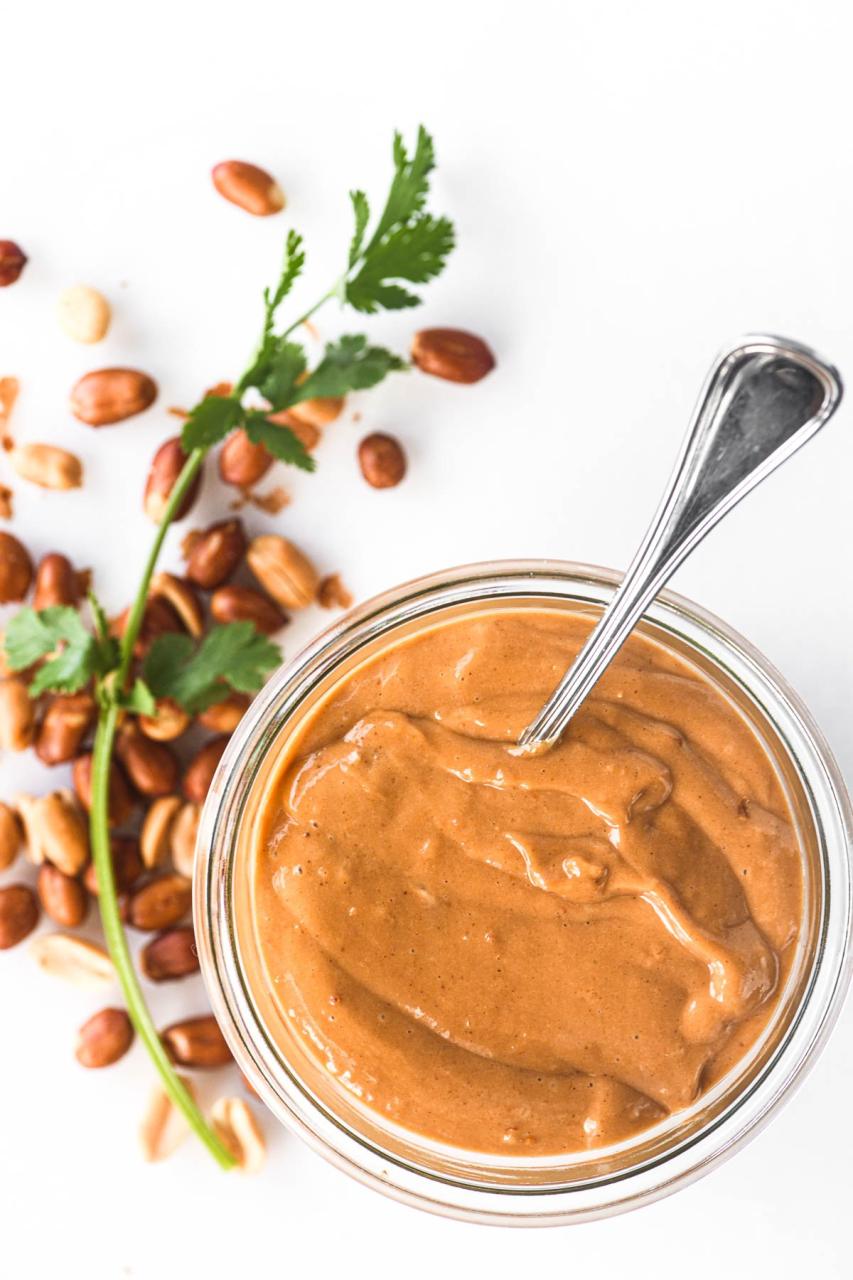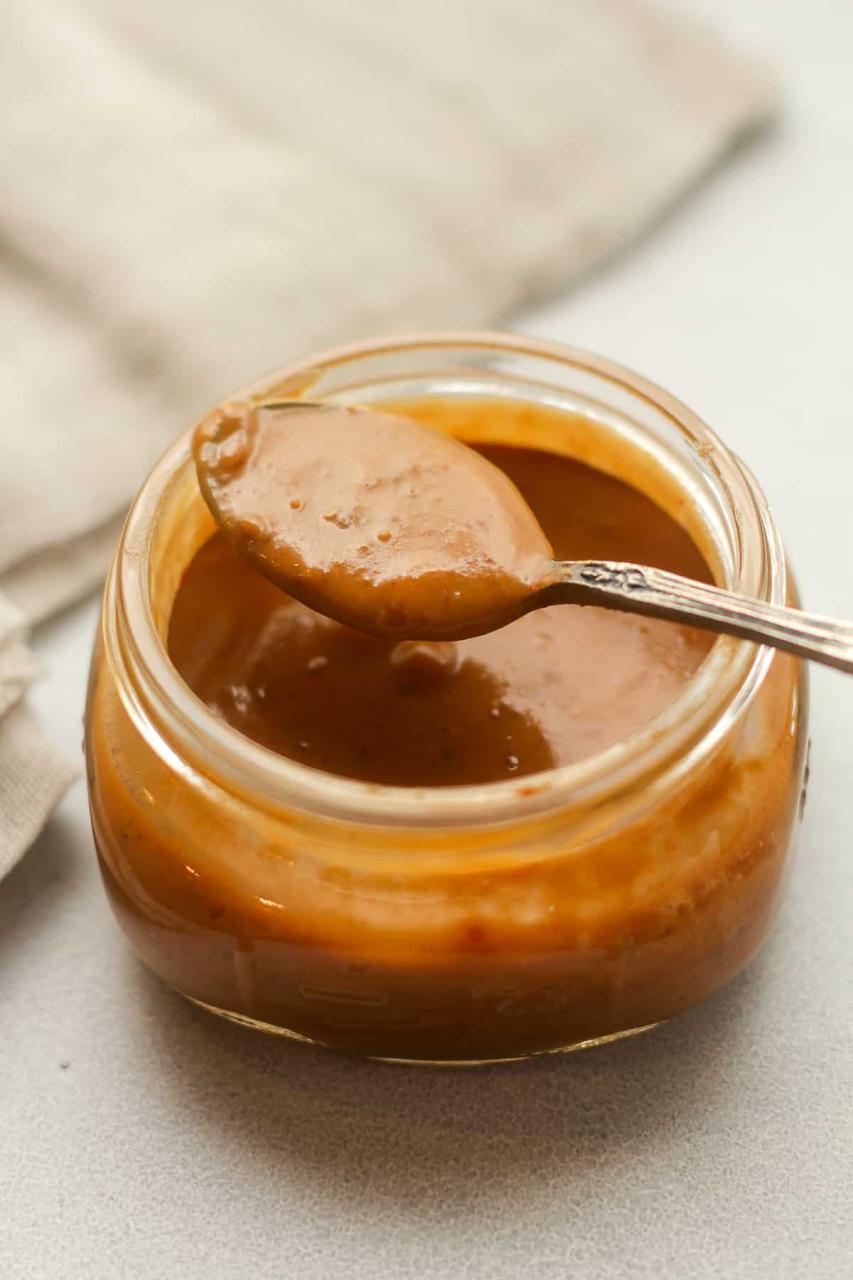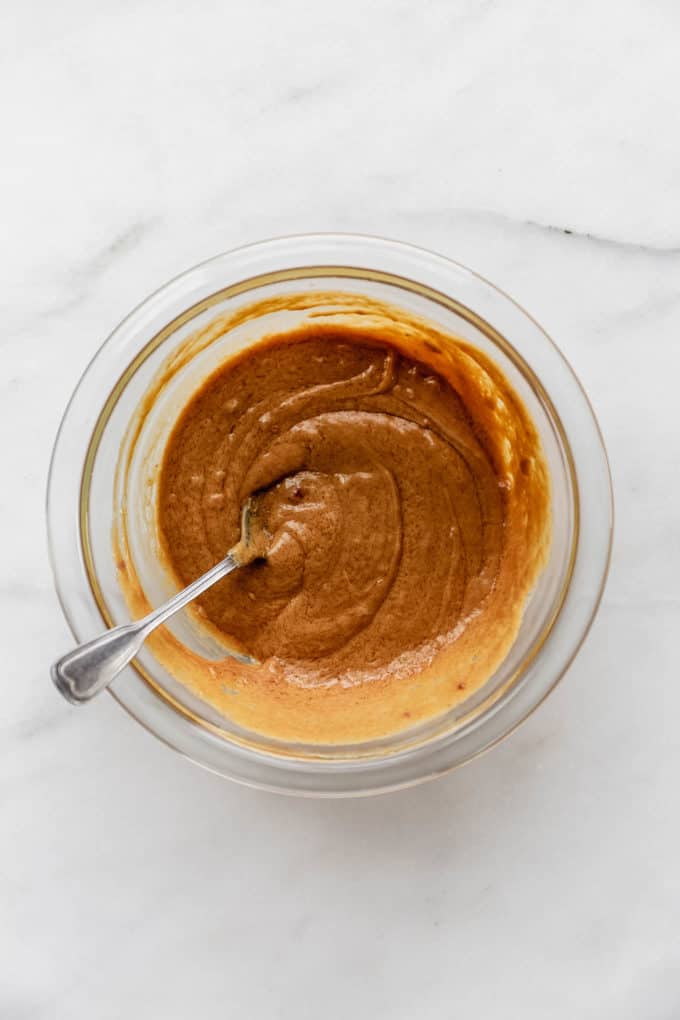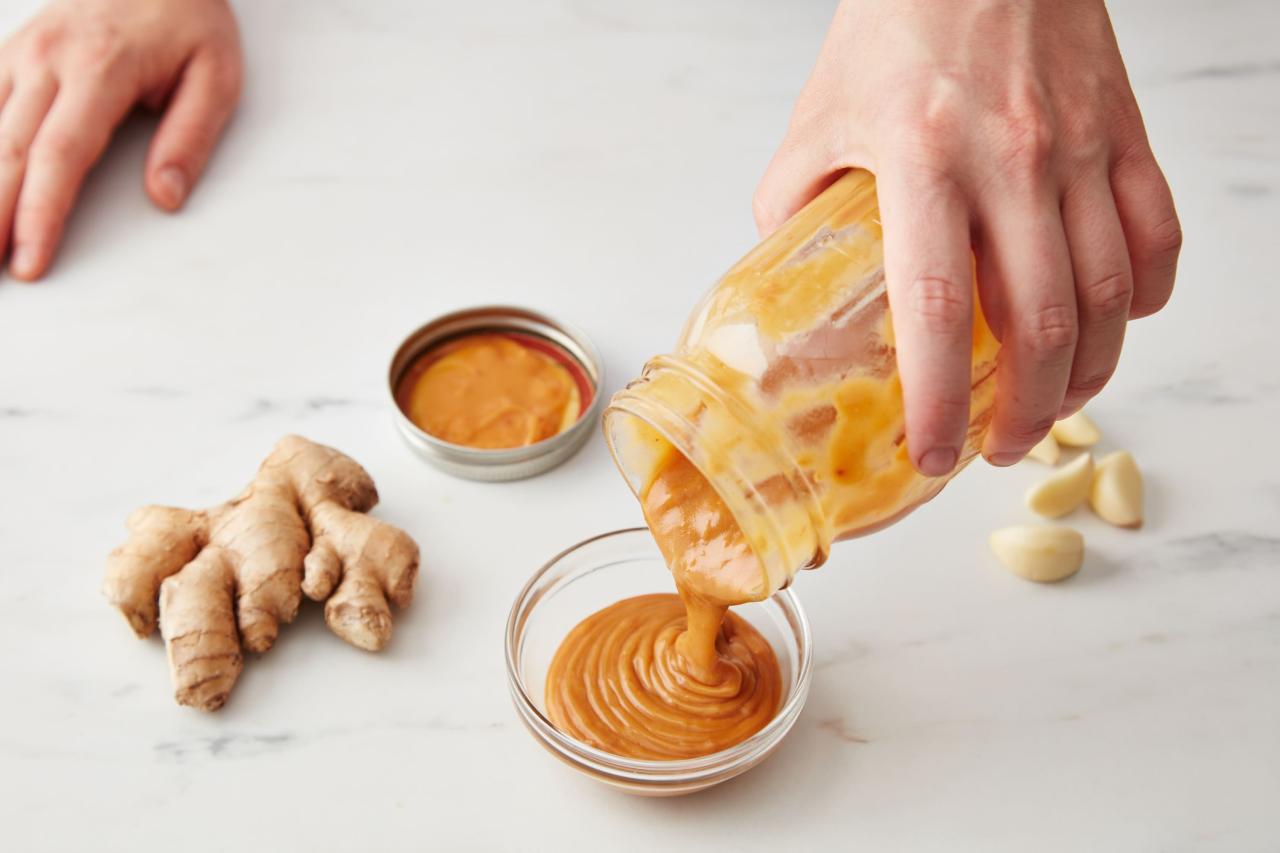Thai cuisine is renowned for its complex flavors, marrying sweet, salty, spicy, and sour elements in a single dish—a characteristic that can be vividly seen in its variety of sauces. A Thai peanut butter sauce, comprised mainly of peanut butter with a mixture of various other ingredients, is a beloved component that can add a rich, savory, and slightly sweet profile to Thai dishes.
The foundational ingredient, peanut butter, provides a creamy base for the sauce. It’s often combined with coconut milk for added richness and a smoother texture, which helps in melding the flavors of the other ingredients. Lime juice is typically added for a tangy contrast to the sweetness of the peanut butter, while fish sauce (or a vegan alternative like soy sauce) contributes a depth of umami flavor and the necessary saltiness. Sweetness is often derived from sugar or a natural sweetening agent such as honey.
Spices and heat are adjustable according to taste preference, but keeping in line with Thai flavor traditions, garlic, ginger, and often some form of chili peppers are included. Fresh herbs like cilantro might be added for a burst of freshness, and in some recipes, tamarind paste is used for a unique sour note that pairs well with the peanut butter.
Healthy versions of Thai peanut butter sauce may focus on using natural, whole ingredients and can include adjustments like using pure, unsweetened peanut butter, swapping in alternative sweeteners with a lower glycemic index, or utilizing light coconut milk. The health-conscious cook might also amplify the sauce’s nutritional profile by adding ingredients high in beneficial properties, such as ginger, known for its anti-inflammatory effects, or garlic, noted for its immune-boosting capabilities.
Such Thai peanut butter sauce can be versatile in its use, acting as a dip for vegetables, a dressing for salads, or a sauce for noodles and proteins. It’s capable of transforming a simple dish into something that has a festive, exotic flavor profile, making it a popular feature in the culinary repertoire of those who appreciate Thai-inspired tastes.
To capture the essence of a healthy Thai peanut butter sauce, one might focus on its flavor balance, nutritional modifications, and its potential to elevate a dish from the ordinary to the extraordinary.
Healthy Thai Peanut Butter Sauce Recipe


Healthy Thai Peanut Butter Sauce
Equipment
- 1 bowl of a blender
Ingredients
- 2 tbsp natural peanut butter
- 2 tbsp soy sauce use low-sodium
- 2 tbsp lemon juice
- 1/2 tsp cayenne or red chili flakes
- 3 dates pitted
- 2 tsp ginger grated
- 2 cloves garlic
- 1/2 cup water
Instructions
- Combine all the ingredients in a bowl of a blender or mini food processor and blend or process until smooth and creamy, start with 1/4 cup of water. Add the rest of the water if needed.
- Taste the dressing and make any necessary adjustment to suit your taste
- To serve with Pad Thai salad, Asian noodles, Buddha bowls, Tofu dishes etc add more water to thin out more but if you want to serve with raw veggies or crackers you don’t need to add any water serve as it is.
- Store any leftover in an air tight container and keep in the fridge, use within a week. It can also be kept in the freezer and thawed in the fridge 2 hour before serving time.
Cooking Tips about Healthy Thai Peanut Butter Sauce

Thai Peanut Butter Sauce, commonly used in Thai cuisine, is known for its rich flavor profile, which balances sweet, salty, sour, and spicy elements. It traditionally contains ingredients like peanut butter, soy sauce, lime juice, brown sugar, garlic, and chili peppers, among others. The sauce is often served with dishes like satay, salads, or noodles.
For a healthier version of a Thai Peanut Butter Sauce, some considerations would be to reduce sugar and sodium content, opt for natural ingredients, and provide alternatives to common allergens like peanuts.
To begin, we can create a base for this sauce with a focus on using unprocessed or minimally processed ingredients to enhance the nutritional profile. Using natural peanut butter—a product with peanuts as the sole ingredient, without added oils or sugar—is a starting point. This approach maximizes the health benefits from the peanuts, which are a good source of protein, healthy fats, and vitamins.
Secondly, reducing the sugar content is paramount when making the sauce healthier. Rather than using brown sugar or honey, one could experiment with sweetness derived from natural sources, such as blended dates or a small amount of pureed fruit, which also add nutrients and fibers.
Sodium content in sauces is typically high due to ingredients like soy sauce. A healthier approach to control the sodium level is to use low-sodium soy sauce or tamari. There’s also the option of coconut aminos, which offer a similar umami flavor profile but with significantly less sodium.
To maintain the classic tangy quality of the sauce without adding extra sugar, one could use more lime juice or add tamarind paste, which imparts a unique sour note intrinsic to many Southeast Asian dishes. Tamarind is a fruit that provides natural tartness and a touch of sweetness without added sugar.
For those with peanut allergies or for a variation in nutrition profile, almond butter or tahini (sesame seed paste) can replace peanut butter. These alternatives will modify the flavor slightly but still yield a delectable sauce with health benefits – like different vitamins and minerals.
Serving suggestions about Healthy Thai Peanut Butter Sauce

Thai cuisine is well-regarded for its balance of sweet, sour, spicy, and savory flavors, with an array of dishes that have become popular worldwide. A classic ingredient used in many Thai recipes is peanut butter, which is used to create savory sauces often paired with dishes such as salads, satay, or noodles. Peanut butter is not only flavorful but also offers nutritional benefits, including healthy fats, protein, and various vitamins and minerals. Nonetheless, it’s calorie-dense, so portion control is important when using it to make a healthy sauce.
When creating a healthy Thai peanut butter sauce, several factors contribute to maintaining its health profile while still delivering on taste. Modifications to traditional recipes can lower calorie content and increase nutritional value without sacrificing flavor. For instance, using natural, unsweetened peanut butter in place of commercially sweetened varieties reduces added sugars. Furthermore, introducing additional components like fresh ginger, garlic, lime juice, and soy sauce also adds different layers of flavor while contributing minimal calories. The inclusion of chili flakes or fresh chili provides a kick that is characteristic of Thai food.
A healthy Thai peanut butter sauce may substitute coconut milk with a lighter version or even broth to reduce calorie and fat content. Sweeteners like honey can be used instead of refined sugars, and in moderation, considering the overall sugar content in one’s diet. Moreover, loading the sauce with fresh herbs, such as cilantro or basil, can enhance both the nutritional value and the complexity of flavors.
Serving suggestions for a healthy Thai peanut butter sauce include using it as a dressing for a vibrant vegetable-packed salad, as a dip for grilled chicken or tofu satay, drizzled over whole grain or zucchini noodles, paired with spring rolls, or as a flavorful addition to a stir-fry. It’s important to pay attention to the quantities used, ensuring that each serving size remains within a healthy calorie range as part of a balanced diet.
If the sauce is intended for individuals with specific dietary concerns or allergies, ingredients can be adjusted. For example, tamari or coconut aminos can replace soy sauce for those avoiding gluten or soy, and pureed pumpkin seeds or sunflower seed butter can be used if there’s a peanut allergy.
Top 5 FAQs about Healthy Thai Peanut Butter Sauce

- What are the primary health benefits of Thai peanut butter sauce? Thai peanut sauce can be considered healthy when consumed in moderation. Peanuts are a good source of protein, healthy fats, and fiber, which can be beneficial for heart health and weight management. Moreover, ingredients like garlic and ginger have anti-inflammatory properties.
- Can a Thai peanut butter sauce be made low-calorie? Yes, to make a lower-calorie version, one can use light coconut milk instead of full-fat, and natural peanut butter without added sugars or fats. Adjustments in the amounts of oil and sweeteners can also help reduce the caloric content while maintaining flavor.
- How can I adapt Thai peanut butter sauce for a vegan diet? To ensure the sauce is vegan, it’s critical to use plant-based ingredients, avoiding fish sauce, commonly found in many Thai dishes, and replacing it with soy sauce or tamari. Honey, if used, should be substituted with a vegan sweetener like agave nectar or maple syrup.
- Is Thai peanut butter sauce gluten-free? This sauce can be gluten-free, but careful attention must be paid to the ingredients used. Soy sauce typically contains gluten, so a gluten-free alternative such as tamari would be suitable. Checking labels for potential gluten contamination in other ingredients is also recommended.
- Can this sauce be used as a dressing or dip, and if so, how should it be adjusted? Thai peanut butter sauce is quite versatile and can be used as a dressing or dip. As a dressing, it may be thinned with a bit of water or additional lime juice to achieve the desired consistency. As a dip, it can be kept thicker, and perhaps the spice levels can be adjusted to cater to different palates.
When considering Thai peanut butter sauce in the context of health, a multifaceted approach is necessary to explore both its nutritional content and its role within a balanced diet.
Nutritional Content: Traditional Thai peanut sauce typically contains ingredients such as peanut butter, coconut milk, soy sauce, garlic, ginger, lime juice, and sometimes sweeteners like honey or sugar. Peanuts themselves are rich in healthy fats, protein, and various micronutrients, including magnesium and vitamin E. Coconut milk provides fats, some of which are medium-chain triglycerides (MCTs) believed to have various health benefits. Ginger and garlic have anti-inflammatory properties and can contribute to enhanced flavor while promoting health.
Caloric Density: One must also consider the caloric density of the sauce due to its high-fat content. While fats are an essential part of a diet, it’s vital to consume them in moderation, especially for individuals watching their caloric intake. The presence of sweeteners could also add to the overall calorie count.
Role within a Diet: From a dietary perspective, the health impact of Thai peanut sauce can be affected by the volume consumed and the frequency of inclusion in meals. As part of a diet that values variety and moderation, this sauce can contribute positively to nutrition when used in moderation. However, if consumed excessively, it might contribute to an unbalanced diet high in calories and fat.
Balance and Moderation: Incorporating Thai peanut sauce into a diet requires a balanced approach. It can be part of a healthy eating plan when used sparingly as a flavor enhancer. It pairs well with vegetables and lean proteins, which can lead to an overall nutritious meal.
Considering these points, it’s clear that Thai peanut sauce can be part of a healthy diet when consumed in moderation, paying close attention to portion sizes, and balanced with other nutrient-dense foods. It brings with it not only flavors that can enhance a meal’s palatability but also a range of nutrients. Like many foods that contain fats and added sweeteners, it should be consumed mindfully.
Leave a Reply